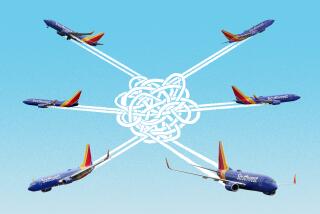PSA to Fade From Skies in Merger
- Share via
SAN DIEGO — Pacific Southwest Airlines, which began flying to West Coast destinations in 1949, is scheduled to fade from the skies within the next few months, a victim of the merger wave that has reduced the number of independent U.S. airlines.
Earlier this year, USAir Group, the nation’s sixth-largest airline and based in Arlington, Va., paid $400 million for San Diego-based PSA, the nation’s 15th-largest airline. USAir has operated PSA as a wholly owned subsidiary since May 30. USAir also recently acquired Piedmont Aviation.
Within months, USAir will blend PSA’s 59 aircraft and 3,800 employees in with its 148 airplanes and 15,700 employees. As part of that merger, it recently started stripping PSA’s bright red and orange corporate colors from the firm’s aircraft and repainting them with USAir’s maroon and red.
Those crews also painted over the fabled “smiles” that led PSA to refer to its aircraft as “Smileliners.”
Shortly after the airplanes are repainted, the two airlines’ schedules will be merged, and the airline that for nearly 20 years has asked the flying public to “catch our smile” will become a part of aviation history.
PSA’s disappearance will close what frequent West Coast fliers have known as an innovative and often colorful chapter in airline history.
PSA began flying commercial passengers on May 6, 1949, with a leased 31-seat DC-3 that flew once a week from San Diego to Oakland with a stop at what is now Burbank Airport. The airline continued to use leased DC-3 aircraft until 1955, when it acquired a 70-seat DC-4.
PSA, which became a public company in 1963, entered the jet age in 1965 with the acquisition of five Boeing 727-100s. It used those jets to build its reputation as the low-cost, high-frequency carrier in the increasingly competitive--and lucrative--”California Corridor” between Los Angeles and San Francisco.
PSA entered the 1970s carrying more than 5 million passengers a year.
It also kept a corporate sense of humor. The last edition of PSA’s in-flight magazine, which was placed on planes only last week, described the airline as having been “bold, brash, sexy, sometimes off the wall but always friendly, always fun.”
That image was in part sparked by PSA’s decision in the early 1970s to dress its stewardesses in miniskirts and boots--a dramatic change from their military-style suits previously worn by flight attendants.
The airline stumbled during the late 1970s and PSA’s airline operations failed to turn a profit between 1979 and 1986, its last independent year.
Most analysts believed PSA was too small to compete with United Air Lines and American Airlines, which in late 1986 acquired Orange County-based AirCal, historically PSA’s chief competitor.
Facing increased competition, the airline successfully won wage and work rule concessions from its union employees, and only recently completed a $1-billion fleet modernization program intended to increase the efficiency of its fleet.
As part of that modernization, PSA became the first major airline in the United States to fly the BAe-146 airliner. In all, PSA acquired 24 of the planes from British Aerospace. It was a BAe-146 jet that crashed Monday.
The only other crash in PSA history--and the airline’s darkest hour--came on Sept. 25, 1978, when a privately owned Cessna 172 collided with a PSA 727 over San Diego, killing 144 people--including 37 employees. “We all knew someone on that flight,” a longtime employee said after the crash.
More to Read
Inside the business of entertainment
The Wide Shot brings you news, analysis and insights on everything from streaming wars to production — and what it all means for the future.
You may occasionally receive promotional content from the Los Angeles Times.










